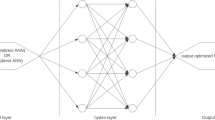Abstract
In this paper input-constrained predictive control strategy for NNARX (neural network non-linear auto-regression with exogenous signal) model of hydro-turbine is presented. The input (gate position) and output (turbine power) data are generated by means of dynamic plant model. The collected data are utilized to develop the NNARX model of the plant. Then NN-based predictive control (NNPC) scheme is applied to control the turbine power. The control cost function (CCF) includes the squared difference between the model predicted output and desired response and a weighted squared change in the control signal. The CCF is minimized with both Quasi-Newton and Levenberg–Marquardt iterative algorithms. To demonstrate the suitability of the strategy, the plant has been simulated on two different reference signals.










Similar content being viewed by others
Abbreviations
- \(\bar{H}_{\rm surge}, \bar{H}_{\rm turbine}\) :
-
head available in riser of surge tank, turbine (p.u.)
- \(\bar{H}_{\rm tunnel}, \bar{H}_{\rm penstock}\) :
-
head loss in tunnel, penstock (p.u.)
- \(\bar{U}_{\rm tunnel}, \bar{U}_{\rm turbine}, \bar{U}_{\rm surge}\) :
-
velocity of water in tunnel, turbine, surge tank (p.u.)
- \(\bar{U}_{\rm noload}\) :
-
velocity of water at no load (p.u.)
- f tunnel, f penstock :
-
head loss coefficient in tunnel, penstock (p.u.)
- C surge :
-
storage constant of surge tank (s)
- \(\bar{H}_{{\rm devia},{\rm tunnel}} \) :
-
head deviation in tunnel (p.u.)
- \(\bar{H}_{{\rm devia},{\rm penstock}} \) :
-
head deviation in penstock (p.u.)
- Z p :
-
hydraulic surge impedance of penstock (=T w/T ep)
- T w :
-
water time constant in penstock (s) \({({= LU_{0}/gH_{0}})},\) T w varies with load
- T ep :
-
elastic time constant of penstock (s)
- T wc :
-
water time constant in tunnel (s)
- L :
-
length of penstock
- U 0 :
-
velocity of water in penstock at rated head (p.u.)
- g :
-
acceleration due to gravity
- H 0 :
-
rated turbine head (p.u.)
- \(\Delta \bar{\omega}\) :
-
deviation of rotor speed (p.u.)
- \(\bar{G}_{\rm opening} \) :
-
gate opening (p.u.)
- D turbine :
-
damping factor or coefficient in p.u. torque/p.u. speed deviation
- A gain :
-
turbine gain
References
Cominos P, Munro N (2002) PID controllers: recent tuning methods and design to specification. IEE Proc Control Theory Appl 149:46–53
Luqing YE, Shouping WEI, Zhaohui LI, Malik OP, Hope GS, Hancock GC (1990) An intelligent self-improving control strategy and its microprocessor-based implementation to a hydro-turbine governing system. Can J Electr Comput Eng 15:130–138
Zhaohui LI, Luqing YE, Shouping WEI, Malik OP, Hope GS, Hancock GC (1991) Field tests with a prototype duplicate microprocessor-based governor for a hydro-turbine. IEEE Trans EC 6:349–355
Zhaohui LI, Luqing YE, Shouping WEI, Malik OP, Hope GS, Hancock GC (1992) Fault tolerance aspects of a highly reliable microprocessor-based water turbine governor. IEEE Trans EC 7:1–7
Zhaohui LI, Malik OP (1997) An orthogonal test approach based control parameter optimization and its application to a hydro-turbine governor. IEEE Trans EC 12:388–393
Lansberry JE, Wozniak L (1992) Optimal hydro generator governor tuning with a genetic algorithm. IEEE Trans EC 7:623–630
Yamamoto T, Kanedam M, Oki T, Watanbe E, Tanaka K (1995) Intelligent tuning PID controllers. In: Proceedings of IEEE conference on intelligent systems for 21st century, 22–25 October 1995
Cheng Y, Ye L, Fu C, Cai W (2002) Anthropomorphic intelligent PID control and its application in hydro turbine governor. In: Proceedings of the first international conference on machine learning and cybernetics, Beijing, 4–5 November 2002
Xu F, Li Y, Qijuan C (1995) Study of the modeling of hydro turbine generating set. In: Proceedings of IEEE/IAS conference on industrial automation and control: emerging technologies, 1995
Qijuan C, Zhihuai X (2000) Dynamic modeling of hydro turbine generating set. In: Proceedings of IEEE international conference on systems, man, and cybernetics, 2000
Chang J, Liu B, Cai W (1996) Nonlinear simulation of hydro turbine governing system based on neural network. In: Proceedings of IEEE international conference on systems, man, and cybernetics, 1996
Nørgaad M, Sørensen PH, Poulsen NK, Ravn O, Hansen LK (1996) Intelligent predictive control of nonlinear processes using neural networks. In: Proceedings of IEEE international symposium on intelligent control, 1996
Draeger A, Engell S, Ranke H (1995) Model predictive control using neural networks. IEEE Control Syst October 1995:61–66
IEEE Working Group (1992) Hydraulic turbine and turbine control models for system dynamic studies. IEEE Trans PAS 7:167–179
Quiroga OD (2000) Modelling and nonlinear control of voltage frequency of hydroelectric power plants. Universidad Politècnica De Cataluña, Spain
Narendra KS, Parthasarathy K (1990) Identification and control of dynamical systems using neural networks. IEEE Trans Neural Netw 1:4–27
Cybenko G (1989) Approximations by superpositions of a sigmoidal function. Math Control Signals Syst 2:303–314
Funahashi K (1989) On the approximate realization of continuous mappings by neural networks. Neural Netw 2:183–192
Nørgaad M (2000) Neural network based system identification toolbox. Technical report 00-E-891, 2000. Department of Automation, Technical University of Denmark
Constantin N (2003) Adaptive neural predictive techniques for nonlinear control. Stud Inf Control 12:285–291
Norgaard M, Ravn O, Poulsen NK, Hansen LK (2000) Neural networks for modeling and control of dynamics systems. Springer, Berlin Heidelberg New York
Author information
Authors and Affiliations
Corresponding author
Additional information
An erratum to this article can be found at http://dx.doi.org/10.1007/s00366-007-0055-0
Appendix
Appendix
Parameters of the system studied:
Z p (T w/T ep)=6.335; T w=2.23 s; T ep=0.352 s; T wc=39.15 s; C surge=240 s; f tunnel=0.0475 p.u.; f penstock=0.089 p.u.; A gain=1.67; \(\bar{U}_{\rm noload} = 0.13\,\hbox{p.u.};\) Δ ω=0.05; D turbine=2.0.
Rights and permissions
About this article
Cite this article
Kishor, N., Singh, S.P., Raghuvanshi, A.S. et al. Comparative performance study of QN and LM algorithms in predictive control for NNARX-identified model of hydro-power plant. Engineering with Computers 23, 71–78 (2007). https://doi.org/10.1007/s00366-006-0024-z
Received:
Accepted:
Published:
Issue Date:
DOI: https://doi.org/10.1007/s00366-006-0024-z




